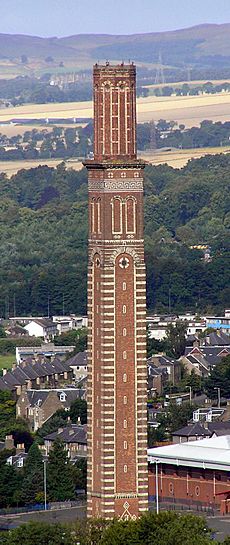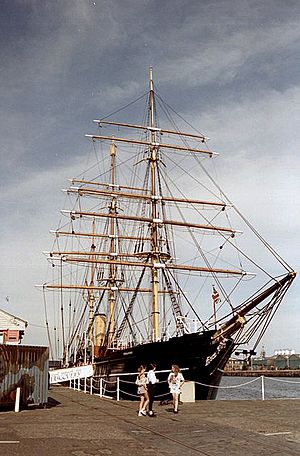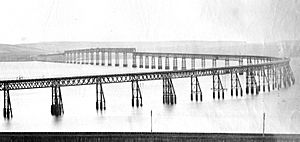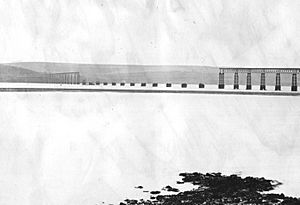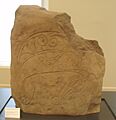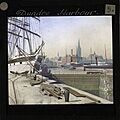History of Dundee facts for kids
Dundee (pronounced Doo-N-Dee) is a lively city in Scotland. It's the fourth-largest city in the country, with about 150,000 people living there. Dundee is located on the north bank of the Firth of Tay, which is an estuary on Scotland's east coast. People have lived in the Dundee area for a very long time, since the Mesolithic period (Middle Stone Age). There is also proof that the Picts, an ancient people of Scotland, lived here during the Iron Age.
During the Middle Ages, Dundee became an important trading port. It was also the location of many battles. Later, during the Industrial Revolution, the city grew very fast because of its jute industry. At this time, Dundee also became famous for its marmalade and its newspapers. This led to the city being known as the place of "jute, jam, and journalism."
Contents
Dundee's Early History
People have lived in the Dundee area for a very long time. Evidence shows continuous settlement since the Mesolithic period. In 1879, during work on the harbour, a very old rubbish heap was found. It contained tools made of flint, charcoal, and a stone axe.
Later, in the Neolithic period (New Stone Age), a special type of ancient monument called a cursus was built. Nearby, the Balgarthno stone circle was also created. Finds from the Bronze Age are common in Dundee. These often include short cist burials, which are small stone-lined graves.
From the Iron Age, the most important remains are from the Law Hill Fort. This was a large fort built on a hill. Other ancient underground passages, called souterrains, have been found nearby. These date back to around 200 AD. There are also ruins of brochs, which are ancient circular stone towers, in the area.
Dundee in the Middle Ages
The early history of Dundee relies a lot on old stories. In Pictish times, the area that became Dundee was a small settlement. It was part of the kingdom of Circinn, later known as Angus. It's thought that the area around Dundee was a special estate, with a castle at its centre.
Dundee became a major town after King William gave the area to his younger brother, David of Scotland, Earl of Huntingdon, in 1179–1182. Earl David is believed to have built Dundee Castle. This castle was located where St Paul's Cathedral stands today.
Dundee's location on the Firth of Tay, with its natural harbour, made it perfect for trade. This helped the town grow a lot as Earl David encouraged it to become a burgh (a town with special trading rights).
When David died in 1219, the burgh was divided among his three sisters. The castle went to his eldest sister, Margaret of Huntingdon, Lady of Galloway. Later, her daughter Dervorguilla of Galloway inherited it. Dervorguilla's share of the town then went to her son, John Balliol. When John became king in 1292, Dundee officially became a Royal Burgh.
At the start of the First War of Scottish Independence in 1296, Edward I of England placed English soldiers in Dundee Castle. However, William Wallace and his forces took the castle back in 1297. This happened just before the famous Battle of Stirling Bridge. Dundee's status as a burgh was confirmed again by Robert the Bruce in 1327.
Dundee's Modern History
Dundee grew a lot during the Industrial Revolution. This was mainly due to the growing trade of the British Empire. The flax industry, and later the jute industry, were very important. By the end of the 1800s, most of the city's workers were employed in jute mills and related businesses.
Dundee's location on a large estuary made it easy to bring in jute from India. It also helped bring in whale oil, which was needed to process the jute. This led to a large whaling industry in the city. A lot of coastal trade also developed between Dundee and London. The jute industry started to decline in the 1900s as it became cheaper to process jute in India. The last jute mill in Dundee closed in the 1970s.
The Three Js: Jute, Jam, and Journalism
Dundee's industrial past is often summed up by "the three Js": jute, jam, and journalism.
Jute Industry
Jute is a strong fibre from India used to make things like sacks, burlap, and twine. In the 1830s, people discovered that treating jute with whale oil made it easier to spin. This led to a huge jute industry in Dundee, creating many jobs.
The jute industry was also known for employing a lot of women. In 1901, 25,000 women worked in jute, making up over 70% of the industry's workers in Dundee. By 1911, this number rose to 75%. Many of these women were married, which was unusual for the time. In 1911, 31,500 people worked in jute in Dundee, which was over 40% of all workers in the city.
Dundee had several very large jute factories. Camperdown Works in Lochee was the biggest jute factory in the world. It was built from 1850 onwards by Cox Brothers. By 1878, it had its own railway line and employed 4,500 workers. Camperdown Works closed in 1981.
The jute industry began to decline around 1914. It became cheaper to import finished jute products from India. By 1951, only 18.5% of Dundee's workers were in the jute industry. Commercial jute production in Dundee stopped in the 1970s. Some companies tried to make synthetic fibres or linoleum instead. The very last jute spinning mill closed in 1999.
Today, an award-winning museum called the Verdant Works celebrates Dundee's jute history. It even has a small jute-processing facility.
Jam Industry
Dundee's connection to jam comes from Janet Keiller's famous "invention" of marmalade in 1797. The story goes that Mrs. Keiller made the recipe to use up a shipment of bitter Seville oranges her husband bought from a Spanish ship. While this story might not be entirely true, as marmalade recipes existed before, the Keillers certainly made it famous.
Marmalade became a well-known Dundee export after Alex Keiller, Janet's son, started making it in large quantities in the 1800s. The Keillers first sold their products from a small sweet shop. Later, Alex Keiller moved the business to a bigger building. Although important to the city's image, the jam industry never employed as many people as the jute industry. Today, you can still buy the distinctive white jars of Keiller's marmalade.
Journalism Industry
Journalism in Dundee mainly refers to the publishing company D. C. Thomson & Co. Ltd. This company was founded in 1905 by David Coupar Thomson. It is still owned and run by the Thomson family.
DC Thomson publishes many newspapers, children's comics, and magazines. These include The Sunday Post, The Courier, Shout, and the popular children's comics The Beano and The Dandy. Journalism is the only "J" that still thrives in Dundee today. DC Thomson is one of the city's largest employers, after local government and the health service, with nearly 2,000 employees.
Maritime Industry
Because Dundee is on a large estuary, it developed a strong maritime industry. It was a whaling port from 1753 and also built many ships. In 1857, the whaling ship Tay was the first in the world to have steam engines. By 1872, Dundee was the top whaling port in the British Isles. This was partly because the local jute industry needed whale oil.
Over 2,000 ships were built in Dundee between 1871 and 1881. This included the famous Antarctic research ship, the RRS Discovery. This ship was used by Robert Falcon Scott for his expeditions. The RRS Discovery was built in Dundee in 1901. It returned to Dundee in April 1986 and is now on display at Discovery Point. The whaling industry in Dundee ended around 1912. Shipbuilding in the city stopped completely in 1987.
The oldest wooden British warship still floating, the HMS Unicorn, is also moored near the Discovery. However, it was not built in Dundee.
The Tay Bridge Disaster
In 1878, a new railway bridge was opened over the River Tay. It connected Dundee to Fife and Edinburgh. This bridge was the longest railway bridge in the world at the time.
However, less than two years after it was finished, the bridge collapsed. This happened during a terrible storm on December 28, 1879. A train full of passengers was crossing the bridge when it fell. None of the passengers survived. The famous poet William McGonagall wrote a poem about this sad event called The Tay Bridge Disaster.
An investigation in 1880 found that the bridge was "badly designed, badly built and badly maintained." The engineer, Thomas Bouch, was blamed. He had used weak cast iron parts that broke in the storm. These parts were not strong enough to handle the weight and the wind. The towers of the bridge were also very top-heavy.
In 1887, a much stronger bridge was built to replace the collapsed one. This new bridge was also very long, over 2 miles.
Public Transport
Dundee has a history of different types of public transport.
Trams
The first public transport in Dundee was by Dundee and District Tramways. From 1877, these were mostly horse-drawn trams. Later, in 1885, steam trams were introduced. The tram lines were owned by the city.
In 1893, the city took full control of the trams. This allowed them to use electric power from overhead lines. The first electric tram in Dundee started on July 12, 1900. The tram network was at its biggest in 1932, with 79 lines. By the 1950s, many trams were old. The last trams were taken out of service in October 1956.
Buses
The first trolleybuses in Scotland were introduced in Dundee between 1912 and 1914. Later, motor buses were added from 1921 to help the tram system. Double-decker buses appeared ten years later. Electric buses were used in some parts of the city until 1961.
In 1975, Dundee's transport became part of the new Tayside Regional Council. The buses got a new dark blue, white, and light blue colour scheme. In 1986, the bus services became a separate company called Tayside Buses. It was later bought by National Express and is now known as Xplore Dundee.
Rail Transport
Rail transport in Dundee began with the Dundee and Newtyle Railway Company in 1826. This was the first railway built in the North of Scotland. It opened in 1832. Other railway lines soon followed, connecting Dundee to Arbroath and Perth.
By the late 1870s, Dundee had three main train stations: Dundee (Tay Bridge), Dundee West, and Dundee East. Many plans were made to combine all these stations into one large central station. However, none of these plans happened. The three separate stations continued to operate.
Dundee used to have local train services to nearby towns like Wormit and Newport-on-Tay. These stopped when the Tay Road Bridge opened. Other local services have also been reduced since the 1980s. Dundee East station closed in 1959, and Dundee West station closed in the 1960s. Now, all train traffic goes to Dundee (Tay Bridge) station, which is simply called Dundee station.
Tay Ferry
A ferry service for passengers and vehicles used to cross the River Tay from Dundee to Newport-on-Tay. This service was very popular. It was stopped in August 1966 when the new Tay Road Bridge opened.
Dundee's Coat of Arms
The city’s coat of arms shows a pot of three silver lilies on a blue shield. Two green dragons support the shield. Above the shield is a single lily and a scroll with the motto Dei Donum, which means 'Gift from God'.
The blue colour of the shield is said to represent the cloak of the Virgin Mary. The silver (white) lilies are also linked to her. An old carving in the city’s Old Steeple shows a similar coat of arms. It depicts Mary protecting her child with a shield from dragons.
The current coat of arms was officially registered in 1673. By this time, Scotland had become a Presbyterian nation. Any strong display of the Virgin Mary was not favoured. This led to the more subtle symbols seen today. There are different ideas about why dragons are used as supporters. One idea is that they represent the rough sea that the Virgin Mary protected David from. Another is that they relate to the local story of the Strathmartine Dragon.
Over the years, small changes happened to the coat of arms. In 1932, the City Council asked for the correct design. They found that the dragons were actually wyverns. Wyverns have two legs, while dragons have four. It was decided to go back to the original design with four-legged dragons and one lily. A second motto was added: ‘Prudentia et Candore’ – meaning 'Wisdom and Truth'.
The coat of arms was changed slightly in 1975 and again in 1996. These changes added a special crown with thistle heads, which is common for Scottish councils.
Important People Connected to Dundee
Many notable people have connections to Dundee.
Winston Churchill
Between 1908 and 1922, Winston Churchill was one of Dundee's Members of Parliament (MPs). At that time, he was a member of the Liberal Party. He was popular at first, especially as he held important government jobs.
However, his frequent absences from Dundee and the difficulties of World War I strained his relationship with the city. By the 1922 election, local newspapers were very critical of him. At one meeting, he could only speak for 40 minutes because people were shouting at him. He couldn't campaign much in the final days because of appendicitis. His wife, Clementine Churchill, was even spat on.
Churchill lost his seat to Edwin Scrymgeour of the Scottish Prohibition Party. Churchill later wrote that he left Dundee "short of an appendix, seat and party." In 1943, he was offered the Freedom of the City of Dundee, but he refused to accept it.
Other Notable People
- Mary Ann Baxter - Co-founder of University College, Dundee.
- Brian Cox – A famous actor.
- William McGonagall – A well-known poet.
- Richard McTaggart - An Olympic gold medalist in boxing.
- Mary Slessor – A missionary who worked in Nigeria.
- Dudley D. Watkins – A famous cartoonist and illustrator.
Dundee's Innovations
Dundee has been home to some important inventions and discoveries.
- James Bowman Lindsay showed his invention of an early electric light bulb at a public meeting in 1835.
- The sticky postage stamp was invented in Dundee by James Chalmers. His tombstone says he was the "Originator of the adhesive postage stamp." This invention helped make the Uniform Penny Post scheme a success.
Archives and History Records
Many of Dundee's historical records are kept in two main places. These are the Dundee City Archives and the University of Dundee's Archive Services.
Dundee City Archives holds official records of the city. It also has records of various groups and people connected to Dundee. The University's Archive Services has many materials about the University itself. It also holds records of businesses and organizations from Dundee. This includes many records about the jute and linen industries.
Images for kids


